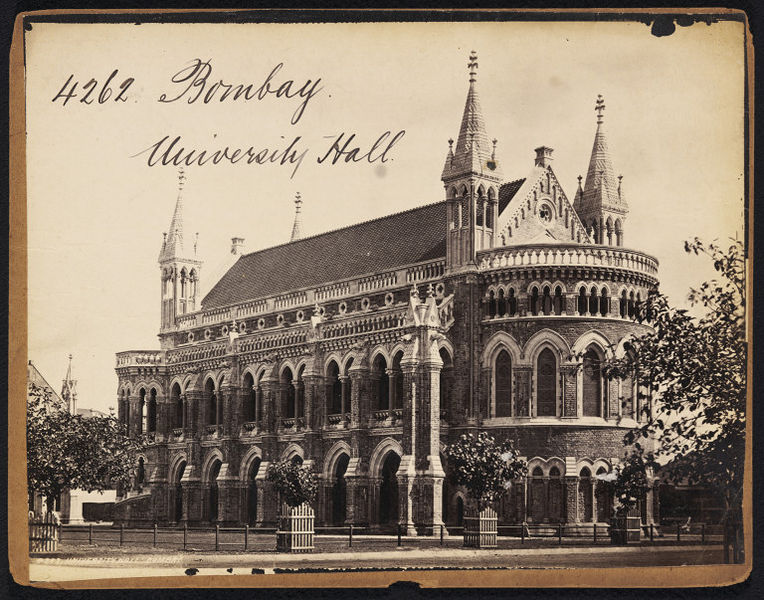फलम्, फले, फलानि… फलम्, फले, फलानि…
Notwithstanding the thundering clouds on a beautiful and rainy Saturday afternoon in Mumbai, one cannot miss this chorus. A motley crowd aged between 20 and 75 is assiduously trying to understand the nuances of Sanskrit grammar in a nondescript department building. Not far off, another group of people is rushing up the stairs so that they can soak themselves in Buddhist iconography while another group in another building is trudging its way through a page of Persian. At first glance, it is tough to believe these familiar scenes in Mumbai University’s Kalina campus on weekends.
For the uninitiated, the campus lies in the vicinity of the country’s financial district – Bandra Kurla Complex (BKC). The symbolism of the setting is worth commenting upon as the trees and the flowers in this oasis are still a far cry from the bricks and glass of the adjoining BKC. Over the last few years, the Mumbai University has been plagued with multiple problems which are too well known to be enumerated here. As we struggle to find solutions to those multifarious and pressing issues, let us for a moment dwell on the scenes that we started this note with.
The weekend tryst with humanities and languages
More than a couple of decades ago, a handful of enterprising and passionate faculty members from various departments at the Mumbai University, teaching primarily humanities and languages, introduced self-funded courses in various disciplines. What is so special about self-funded courses – one may ask? It is the positioning and the availability and the variety!
Knowingly or unknowingly they attract enthusiasts and/or others yearning to learn subjects that they could not focus on during their formal higher education. The students of these certificate or diploma courses come from all walks of life. To my sheer delight, I have met everyone from homemakers to retired teachers and engineers and from corporate CEOs and doctors to artists and musicians. Most of these courses are conducted on weekends or during off-business hours. The schedules are packed with lectures, assignments, study tours, readings and examinations. There are those who attend the lectures but miss the final examinations and there are those who pore over reams of notes to make sure that they can write for three hours at the end of the year.
There are choices galore. The Department of Philosophy has Indian Aesthetics, Jainology and Yoga on offer, the Sanskrit Department offers Comparative Mythology and Mysticism in addition to Sanskrit while the Centre for Extra Mural Studies offers Archaeology, Geology and Indian Arts and Sciences. Of course, you can choose from Pali and Prakrit, French and Japanese, Persian and Urdu. The list goes on.

A brick and mortar experiment to promote lifelong learning
Is all hunky-dory with these courses? No – it is not. They have their fair share of problems. Nevertheless, they deserve attention. Indian culture has forever stressed the need for स्वाध्याय (Swadhyaya) – loosely translated as self-learning. Continuous learning and lifelong learning are the new buzzwords. Thousands of blogs and talks exhort people to expand their horizons by learning something new. There are e-learning portals to address these needs. These courses at the Mumbai University definitely help in all of the above. The completion rates which anecdotally hover around the half-way mark are far better than online averages.
More importantly, these courses also provide at least one alternate solution to reinvigorating education in humanities and languages on a different plane. As more and more students migrate to focussed, vocational education at the graduate level, we will need newer models that will allow people to return to liberal disciplines. Part-time courses alluded to above give individuals a chance to come back and explore vistas of knowledge that eluded them henceforth. In addition, some of the senior students are capable of providing monetary assistance to these departments that are otherwise starved for resources and some of them go on to do invaluable research in their chosen areas. For some, they also open up newer career opportunities.
There is little doubt that a lot is broken in our country’s education system and the recent debates around the National Education Policy (NEP) are far from being settled. But unsung, minuscule experiments like these provide a glimmer of hope. The Mumbai University experiment is at a nascent stage and is largely driven by enterprising individuals. One may argue that that is precisely the reason for its survival and bureaucracy will strangle it. While the argument largely holds, a lot more can be done to harness the collective power of the students who attend these courses, to scale up this experiment and to make them more coveted than they are today. The experiment can serve as a model for other universities in India which can open up their hallowed portals not only for community members to come and learn and help in enriching education but also to further the cause of स्वाध्याय and lifelong learning.

Maximum City – Maximum Options
My parting note – if you live in Mumbai and would like to do something different yet stimulating on weekends, hop over to the University and figure out what is of interest to you. Having spent many a memorable weekend at the campus for over 10 years both as a student and as a guest faculty member, I can aver that on the balance, the experience will leave you richer.


Very well written. Makes us proud to be the part of this Knowledge Legacy.
Thank you for your kind words Dr. Deshpande…It is largely due to efforts of passionate individuals like you that a legacy is being built…more power to educators…
Thanks for sharing this! I had no idea such options existed.
Thanks Rashmi…hope and your friends benefit from them…all the best…
I have soaked myself in many of these courses over 19 years of my tryst with these week-end bonanza. This is unique effort by university. I am thankful to the university for providing such an opportunity
Thanks Dr. Vora. You truly exemplify the virtues of स्वाध्याय…
This is beautifully put across Garima… And very interesting. I may just sign up for a short course in the near future. ☺️☺️ Thanks for sharing! ??
Thanks Karishma… hope you enjoy the course!
Nice